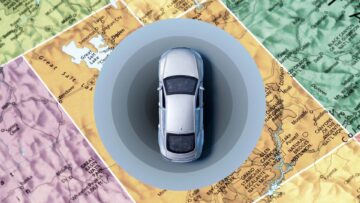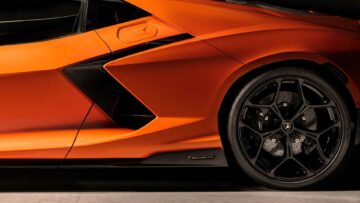The Audi Q6 E-Tron will launch with new active lighting technology that makes this EV smarter and safer, but the feature won’t be coming to the United States. And before you boo Audi, here’s a reality check: Federal red tape is still to blame.
Audi has long equipped its cars with adaptive matrix LED headlights that can dim or brighten as they detect oncoming light. In other words, an Audi can drive with its headlights at full brightness, giving the driver maximum visibility at night, but the individual LED sections can automatically dim to not blind oncoming traffic. Here’s a quick refresher on how this works.

[embedded content]
Audi has been installing its matrix LED technology on some vehicles sold in the US for nearly a decade, but has left the function turned off. In Feb. 2022, the National Highway Traffic Safety Administration (NHTSA) amended Federal Motor Vehicle Safety Standard No. 108, allowing adaptive driving beam (ADB) lighting like Audi’s, but the ruling actually complicated matters, arguably making it more difficult to turn on these systems.
“The US had a specific regulation that only allowed for a high or a low beam, but nothing in between,” Audi said in a statement. “A new regulation was passed that allowed for adaptive beam lighting. However, the ruling also established differing requirements in terms of testing and certification than the globally accepted and SAE (Society of Automotive Engineers) informed solution. This is the solution we have offered outside of the US since 2012.”
“The new regulation requires different testing procedures, methodologies, and criteria than the rest of the world and it appears no current systems can meet those requirements,” Audi added.
Interestingly, safety groups cautioned NHTSA against this very thing years ago. “We are concerned that specific components of the [amendment] will unnecessarily prevent manufacturers from implementing ADB systems that fully realize their potential to maximize visibility and minimize glare,” the Insurance Institute for Highway Safety said in a 2018 petition.
“Our lighting standard, FMVSS No. 108, has long balanced the seeing needs of drivers while limiting glare to others,” NHTSA said in a statement.
The Q6 E-Tron, a prototype of which we recently drove, expands on Audi’s matrix-beam technology by offering active lighting. If equipped with this option, the Q6 E-Tron can change between eight different front running light designs, some of which have a twinkling effect that you won’t immediately notice, but look at the lights long enough and it becomes apparent. Ditto the rear; the OLED taillights have this same shimmering look, which is something no other automaker offers.
But there’s a safety angle, too. If the Audi Q6 E-Tron’s navigation system detects a traffic jam or accident ahead, it can change the rear OLED display to show a warning triangle, alerting the drivers behind you that something’s happening up ahead. Similarly, when the Q6 E-Tron is in its automated parallel parking mode, the car’s taillights will put up this signature along with the blinker, letting people know you’re backing into that space.
These small functions don’t drastically enhance Audi’s matrix lighting, but they’re a step in a new direction. In the meantime, the US-spec Q6 E-Tron will have different LED running light signatures available, they’re just static – you know, “steady burning.” If and when the US ever evolves its lighting standards to match the rest of the world, Audi says it can turn on the full matrix feature set for thousands of vehicles, including older models. Here’s hoping.
- SEO Powered Content & PR Distribution. Get Amplified Today.
- PlatoData.Network Vertical Generative Ai. Empower Yourself. Access Here.
- PlatoAiStream. Web3 Intelligence. Knowledge Amplified. Access Here.
- PlatoESG. Automotive / EVs, Carbon, CleanTech, Energy, Environment, Solar, Waste Management. Access Here.
- BlockOffsets. Modernizing Environmental Offset Ownership. Access Here.
- Source: https://www.motor1.com/news/678464/audi-q6-etron-active-headlights-not-offered-in-us/
- :has
- :is
- :not
- $UP
- 100
- 16
- 2012
- 2018
- 2022
- 2025
- 49
- 9
- a
- accepted
- accident
- active
- actually
- added
- administration
- against
- ago
- ahead
- allowed
- Allowing
- along
- also
- an
- and
- apparent
- ARE
- arguably
- AS
- At
- audi
- Automated
- automatically
- automotive
- available
- backing
- balanced
- BE
- Beam
- becomes
- been
- before
- behind
- between
- blind
- BOO
- burning
- but
- by
- CAN
- cars
- Certification
- change
- check
- coming
- complicated
- components
- concerned
- content
- criteria
- Current
- data
- decade
- designs
- detect
- different
- differing
- difficult
- direction
- Display
- Dont
- drastically
- drive
- driver
- drivers
- driving
- effect
- eight
- embedded
- Engineers
- enhance
- enough
- equipped
- established
- Ether (ETH)
- EV
- EVER
- evolves
- expands
- false
- Feature
- Feb
- Federal
- First
- For
- from
- front
- full
- fully
- function
- functions
- Giving
- Globally
- Group’s
- had
- Happening
- Have
- here
- High
- Highway
- highway safety
- hoping
- How
- However
- HTTPS
- if
- image
- immediately
- implementing
- in
- In other
- Including
- individual
- informed
- installing
- Institute
- insurance
- into
- IT
- ITS
- jpg
- just
- Know
- Label
- launch
- Led
- left
- letting
- light
- Lighting
- like
- limiting
- Long
- Look
- Low
- MAKES
- Making
- Manufacturers
- Match
- Matrix
- Matters
- max-width
- Maximize
- maximum
- meantime
- Meet
- methodologies
- minimize
- Mode
- models
- more
- Motor
- name
- National
- Navigation
- nearly
- needs
- New
- night
- no
- nothing
- Notice..
- of
- off
- offered
- offering
- Offers
- older
- Oled
- on
- only
- Option
- or
- Other
- Others
- our
- outside
- Parallel
- parking
- passed
- People
- plato
- Plato Data Intelligence
- PlatoData
- player
- potential
- prevent
- procedures
- prototype
- put
- Quick
- Reality
- realize
- recently
- Red
- Regulation
- Requirements
- requires
- REST
- review
- ruling
- running
- s
- safer
- Safety
- Said
- same
- says
- sections
- seeing
- set
- show
- signature
- Signatures
- Similarly
- since
- small
- smarter
- Society
- sold
- solution
- some
- something
- Space
- specific
- standard
- standards
- Statement
- States
- Step
- Still
- system
- Systems
- Technology
- terms
- Testing
- than
- that
- The
- the world
- their
- These
- they
- thing
- this
- those
- thousands
- to
- too
- traffic
- true
- TURN
- Turned
- United
- United States
- unnecessarily
- us
- value
- vehicle
- Vehicles
- very
- Video
- visibility
- warning
- was
- we
- webp
- when
- which
- while
- why
- will
- with
- words
- works
- world
- years
- you
- youtube
- zephyrnet











